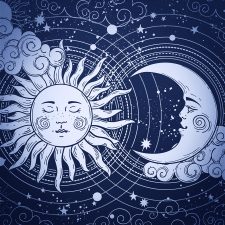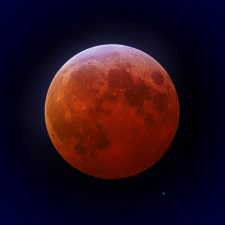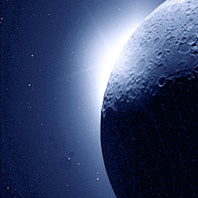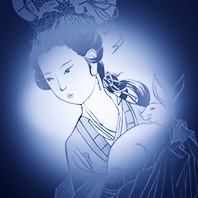The words “full moon” in many languages

It is said that there are more than 6,000 languages worldwide (this is hard to imagine) and it is a fascinating concept to think, there are probably as many words for “full moon”.
Here we begin our little journey to the full moon. A few words about the fascinating quest of the greater purpose, that includes the full moon circulating through our lives. In layman’s terms and not always scientific (astronomy experts – don’t look too closely!). We would like to wish you illuminating moments. Enjoy!


It is said that there are more than 6,000 languages worldwide (this is hard to imagine) and it is a fascinating concept to think, there are probably as many words for “full moon”.

A full moon is when the Sun and the Moon are facing opposite, being in opposite direction from an Earth perspective.
This might feel astonishing if one imagines that the Moon is on one side, the Sun on the other and the Earth in between? Shouldn’t the Earth throw a shadow onto the Moon? Bingo – this is exactly what she does! But only when the Moon is exactly on the Earth orbit, the so called “ecliptic”. When this takes place, we speak of a lunar eclipse!

The Moon needs 27.33 days to circle around the Earth. Something that is also referred to as “sidereal time”. But because the Earth orbits the Sun, just like the Moon orbits the Earth, the Moon has to travel two further days in order to resume the same position to the Earth and Sun. This is then called the “sidereal time”. In order to determine the point of time of the reoccurring full moon, the sidereal time serves as basis.

We already know now that the moon month is mostly shorter than the calendar month, being on average approximately 29.5 days. If full moon falls on the first or second of a month, it is possible that another full moon occurs in the same month, for instance in July 2004:
Friday, 2 July 2004, 01:08:54 pm
Saturday, 31 July 2004, 08:05:06 pm
This event is also known as “blue moon”.

The answer is: “everywhere at the same time”. This refers to the so called Universal Time (UT) though, which is used for general astronomical events. We have already learnt that full moon is an astronomical event, where the moon, sun and the earth play a role by being in a specific position. So, full moon takes place at a specific time in the outer space. This point of time is specified by astronomers namely by the Universal Time.

There are multiple ways of approaching this question. If we look at it from a purely theoretical standpoint, we might be tempted to say that the full moon is infinitely short, since the phases of the moon are changing continuously. The moon is not yet quite full shortly before the full moon, and is already waning shortly afterwards.
However, there is a practical aspect that lets us quantify the full moon as a finite and measurable span of time: Since the Sun is significantly bigger than the Moon, its rays are able to reach just a little over half of the Moon’s surface. This means that the timespan in which the visible side of the Moon’s surface is irradiated (as seen from Earth) is longer than infinitely short.

Whether scientists, astrologers or esoterics, they agree on one thing: the moon influences earth and life on earth. For instance, it regulates the tides through its magnetism. Also continents feel the consequence of this magnetism and either raise or lower their position sometimes up to 26 cm.

In nature it is a known fact: for some animal species, mating takes place at full moon. However, the examples that can be found on this subject are rather simple. Full moon serves in some cases indirectly as the cause (for instance through the high water levels during the tides that the horseshoe crab uses to deposit its eggs) or also as the signal for both sexes of a species to begin at the exact same time to safeguard their future existence (a particular type of fly or also corals). It is understood that also wolves are led by full moon when it is time to mate.

… that people are looking for an argument at full moon or are especially happy …
… that if full moon is surrounded by a haze, a person dies …
… that you raise your hat three times to the moon (being a man) or you make a curtsey (being a woman), in order to protect yourself from misfortune until the next full moon …
… that whoever does not chink glasses with full moon at least once, does not deserve any happiness [Greek toast] …

During a lunar eclipse, the Moon moves through the shadow of the Earth. Which means, that the Earth is positioned quite exactly between the Sun and Moon and casts its shadow onto the Moon. This is only possible at full moon and if some other requirements are met. Depending on whether the moon passes the partial or the core shadow of the Earth, we speak of a partial or total lunar eclipse.

Just recently, NASA found out, during an examination of video material, that a relatively large explosion took place on the Moon on 17th March 2013, caused by the impact of a meteoroid. This was an approximately 15 inches large and 88 pounds heavy chunk, which hit the Moon’s surface with 56,000 mph. The explosive power is equivalent to 5 tons of TNT. The flash of light which lit up during the impact in the »Mare Imbrium«, was so bright that it was visible with the naked eye from Earth.

They have probably never met in person, Frank Sinatra (1915–1998), the American singer and entertainer and Sergei Rachmaninoff (1873–1943), the Russian pianist and composer, although, mathematically speaking, it might have been possible. However, almost two generations lay between both musicians and stylistically they are worlds apart. But there is a meeting point indeed, that even has to do with the full moon.
The American-British space thriller »Gravity« of 2013, offers next to its extraordinary suspenseful action, breathtaking images of space that show apart from the Earth and the Sun also the Moon. The director of the movie is Alfonso Cuarón (who also directed Harry Potter and the Prisoner of Azkaban). The movie is commercially very successful and has already brought in the multiple of its production cost, shortly after its release.

Shortly before Easter, we are taking a look at Christianity and notice that a very important event must have taken place at the full moon: the Last Supper of Jesus and his disciples. From a historical point of view, the Last Supper derives from the Jewish Passover feast (Seder), which traditionally takes place on the eve of Passover. This meal is being celebrated on the 14th Nisan, which is always the first full moon after the spring equinox – the beginning of spring. This is how later, the calculation of the Easter date had been determined: »Easter takes place on the Sunday after the first full moon in spring.«

The full moon has always been a companion through time, through months, through seasons and the entire year. In the early days even more so, because daily life of people had not been strictly ruled by the clock yet. It was the sun that determined the day and the moon that brightened the night. Nowadays, clock and calendar are our time scales, which is advantageous but also contains a dark side. You unlearn more and more to estimate time periods and to experience them consciously. We have almost forgotten to perceive how different a full moon feels like in December compared to a full moon in July …

Everyone knows that about once a month is full moon … but, strangely enough, a full moon is always on a different day each month and always at a different time. The reason is that the moon month is shorter on the average, than the calendar month. Without being to mathematical, one can say that a moon cycle lasts approx. 29.5 days. This is how the time of full moon spreads irregularly throughout the calender months and it happens (about every 2.5 years) that two full moon dates fall onto the same month, one at the beginning and one at the end of the month. This second full moon is called a “blue moon” today.

More than 400 years ago, the German artist Adam Elsheimer (1578–1610) painted the picture »Flight into Egypt« (1609), where he depicted the well-known biblical scene of the escape of Joseph and Maria with the Christ Child. The special feature of this painting is, that it shows the full moon and night sky with such a richness of detail on a scale not seen before. Scientists – like for example Dr. Christian Sicka of the ›Deutsche Museum‹ Munich – have examined this work and come to the conclusion that this is possibly the first correct astronomical true to life depiction of the night sky in paintings. One can easily recognise the lunar maria on the Moon’s surface and also the Milky Way, moreover a clear graduation of brightness with the individual stars.

Although, one could assume that the following concerns vampires or werewolves, we occupy ourselves with another kind of bite, namely the bite of animals to humans. There is a study of the E.R. department of the Bradford Royal Infirmatory in Bradford, England from 1997–1999. Here, the question, whether animals bite more often at the full moon, has been investigated. 1,621 patients were looked at, who had been treated for animal bites. The majority of affected patients had been bitten by dogs (95.1 %), others by cats (3.4 %), horses (0.8%) and rats (0.7 %). The surprising aspect of this study is, that indeed a significant connections could be detected between the full moon happenings and the animal bites. Hence, this should be the first study, known to us, which provides such a result!

Chang’e is the Chinese moon goddess. She does not symbolically represent the Moon, like for example the Greek moon goddess Selene, but Chang’e lives on the Moon and is befriended with the well-known rabbit that is very familiar to us. But has she always been up there?
The legend says that she got there some thousand years ago. There are different versions of the story, which we don’t want to elaborate on. In any case, her husband Hou Yi plays a central role, who came to help because of his skillfulness in archery, when ten suns threatened to burn the Earth and he shot down nine from the sky.

»The Lion King« from 1994, is one of the most successful animated movies, and just like in other works from the house of Walt Disney (»The Lady and the Tramp« and others), we are able to gaze at the full moon up in the sky in nightly scenes.
Particularly well-known is the image, where Simba dances across a tree trunk with his companions, which enables them to cross a large river in front of the backdrop of a gigantic full moon. This motif has also been used for various movie posters and can also be watched in the movie trailer: